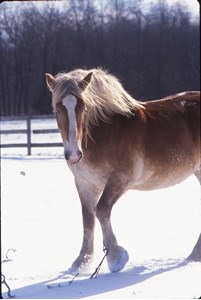New research from England suggests that the fat that accumulates along a horse’s crest may be distinctly different from deposits elsewhere on his body.

The study, conducted at the University of Bristol, was based on 96 horses with access to pasture for more than six hours per day. The horses were assessed at the end of winter and again at the end of summer and assigned a cresty neck score (CNS) for each season.
Determined through visual assessment as well as by palpating the area, CNS is a 0 to 5 scale used to describe the amount of fat along the top of a horse’s neck. A score of 0 correlates to “no visual appearance of a crest and no palpable crest” while 5 indicates a “crest that is so large it permanently droops to one side.” In earlier studies, cresty necks have been associated with a higher risk of laminitis.
“The cresty neck score was developed by researchers at Virginia Tech, initially as a body condition score system that was less breed specific than the more famous Henneke 9-point scale, which was developed specifically for lightweight breeds,” explains Sarah Giles, MSc, PhD. “Yet it has shown to hold up remarkably well in a range of breeds when tested against actual fat content and also to differentiate between more ‘metabolically risky’ cresty neck adiposity from general obesity.”
When the researchers compared each horse’s scores for the summer and the winter, they discovered an unexpected pattern: The scores declined in the summer months and increased during the winter. “In the same population, general adiposity [fat elsewhere on the body] showed the opposite pattern of seasonal association, being highest at the end of the summer months,” says Giles.
This difference, the researchers hypothesize, could reflect the physiological function of crest fat. “Potentially, the nuchal crest might be the site of more long-term fat storage and therefore does not experience the same seasonal fluctuation based on food availability,” says Giles It is also possible the CNS isn’t sensitive enough to measure seasonal fluctuations in fat, she says, although further studies would be needed to verify that.
Also unknown is whether horses whose CNS scores fluctuate significantly over the course of a year are at a greater or reduced risk of laminitis than other horses. “This study really poses more questions than it answers as the results were just so surprising,” says Giles. “The potential differences between cresty neck adiposity and more general obesity need to be more fully investigated.”
Reference: “Assessing the seasonal prevalence and risk factors for nuchal crest adiposity in domestic horses and ponies using the cresty neck score,” BMC Veterinary Research, January 2015
This article first appeared in EQUUS issue #456, September 2015.








